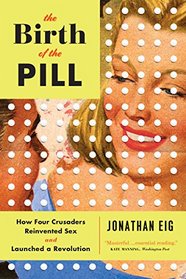Leo T. reviewed The Birth of the Pill: How Four Crusaders Reinvented Sex and Launched a Revolution on + 1775 more book reviews
A well-written book. My notes for a three minute lecture:
Chapter One. The Birth of The Pill.
Working on birth control was âdirty, disreputable work (4).â And if there was a breakthrough, no M.D. would prescribe it nor would a manufacturer be available in 1950, despite large post-war investments in scientific research. But the war had left a less staid America as Dr. Kinsey's research found. Margaret Sanger wanted sexual intercourse to be about the pleasure of women, not only for marriage and children (6).
Chapter Two. A Short History of Sex (pp. 12-20). CAUTION: this is very dubious for class useâ¦.
Well-written and brings the situation in the 1950s into focus via Freud, Reich, Kinsey and Hefner. Eig says Kinsey's most significant conclusion was âwomen desired sex, and not just to make babies (17).â
Chapter Eight. The Socialite and the Sex Maniac (pp. 90-97).
(Lesson Plan with Early 20th C. suffrage?) Katherine Dexter McCormick married Stanley McCormick, son of Cyrus, in 1904, was widowed in 1947, was a graduate of MIT, and provided the funds to develop the pill.
Chapter 26. Jack Searle's Big Bet (top of p. 244 through p. 248).
G.D. Searle was a small pharmaceutical company led by a CEO who invested heavily in R&D (Metamucil, a laxative, was marketed in 1934 and made G.D. Searle a firm with salves over $1,000,000 annually). Jack Searle âput his company's reputation and resources behind one of the most daring and controversial products in history (245).â
Chapter 27. The Birth of The Pill (pp. 249-257).
Trials were done in Puerto Rico where the poverty that came from overpopulation was only too obvious. Pincus worked on reducing the side effects, which eventually was done best with lower dosage Enovid-E. (Enovid pronounced eh-NAH-vid). Note that it was illegal to test the pill in the US. The Enovid application to the FDA was for treatment of menstrual cycles, not for contraception. Searle was lucky to get ahead of the Thalidomide scandal.
Chapter 34. Epilogue (pp. 309-323).
The Pill is âpart of lifeâ today but looking back âit seems unbelievable that a group of brave rebellious misfitsâSanger, Pincus, McCormick, and Rockâmade such a radical breakthrough, and did it with no government funds and comparatively little corporate money (309).â
The Catholic Church considered birth control and Paul VI opposed it in 1968.
In 1964 Searle sold an improved formulation, Enovid-E for $2.25 a month in the USA. Due to the need to take a pill daily, the pill worked best in practice for well-organized, better off women.
Sanger's hope of the pill curbing population growth was unrealized: 3 billion in 1960 and 7.3 billion today.
A side effect of the pill: sale of C-cup bras rose 50% in the 1960s.
See Claudia Goldin (Economics, Harvard) research for the pill lessening a social problem for employed womenâthey could date and defer marriage without being considered an old maid.
Chapter One. The Birth of The Pill.
Working on birth control was âdirty, disreputable work (4).â And if there was a breakthrough, no M.D. would prescribe it nor would a manufacturer be available in 1950, despite large post-war investments in scientific research. But the war had left a less staid America as Dr. Kinsey's research found. Margaret Sanger wanted sexual intercourse to be about the pleasure of women, not only for marriage and children (6).
Chapter Two. A Short History of Sex (pp. 12-20). CAUTION: this is very dubious for class useâ¦.
Well-written and brings the situation in the 1950s into focus via Freud, Reich, Kinsey and Hefner. Eig says Kinsey's most significant conclusion was âwomen desired sex, and not just to make babies (17).â
Chapter Eight. The Socialite and the Sex Maniac (pp. 90-97).
(Lesson Plan with Early 20th C. suffrage?) Katherine Dexter McCormick married Stanley McCormick, son of Cyrus, in 1904, was widowed in 1947, was a graduate of MIT, and provided the funds to develop the pill.
Chapter 26. Jack Searle's Big Bet (top of p. 244 through p. 248).
G.D. Searle was a small pharmaceutical company led by a CEO who invested heavily in R&D (Metamucil, a laxative, was marketed in 1934 and made G.D. Searle a firm with salves over $1,000,000 annually). Jack Searle âput his company's reputation and resources behind one of the most daring and controversial products in history (245).â
Chapter 27. The Birth of The Pill (pp. 249-257).
Trials were done in Puerto Rico where the poverty that came from overpopulation was only too obvious. Pincus worked on reducing the side effects, which eventually was done best with lower dosage Enovid-E. (Enovid pronounced eh-NAH-vid). Note that it was illegal to test the pill in the US. The Enovid application to the FDA was for treatment of menstrual cycles, not for contraception. Searle was lucky to get ahead of the Thalidomide scandal.
Chapter 34. Epilogue (pp. 309-323).
The Pill is âpart of lifeâ today but looking back âit seems unbelievable that a group of brave rebellious misfitsâSanger, Pincus, McCormick, and Rockâmade such a radical breakthrough, and did it with no government funds and comparatively little corporate money (309).â
The Catholic Church considered birth control and Paul VI opposed it in 1968.
In 1964 Searle sold an improved formulation, Enovid-E for $2.25 a month in the USA. Due to the need to take a pill daily, the pill worked best in practice for well-organized, better off women.
Sanger's hope of the pill curbing population growth was unrealized: 3 billion in 1960 and 7.3 billion today.
A side effect of the pill: sale of C-cup bras rose 50% in the 1960s.
See Claudia Goldin (Economics, Harvard) research for the pill lessening a social problem for employed womenâthey could date and defer marriage without being considered an old maid.




